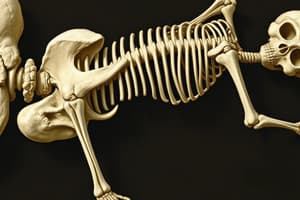Podcast
Questions and Answers
Which part of the skeleton forms the central axis of the body?
Which part of the skeleton forms the central axis of the body?
- Axial Skeleton (correct)
- Appendicular Skeleton
- Shoulder Girdle
- Pelvic Girdle
The appendicular skeleton is primarily responsible for protecting vital organs.
The appendicular skeleton is primarily responsible for protecting vital organs.
False (B)
What is one of the key functions of the skeletal system?
What is one of the key functions of the skeletal system?
Support
The bones of the arms, legs, hands, and feet are part of the __________ skeleton.
The bones of the arms, legs, hands, and feet are part of the __________ skeleton.
Match the following skeletal system functions with their descriptions:
Match the following skeletal system functions with their descriptions:
Which of the following bones is classified as a long bone?
Which of the following bones is classified as a long bone?
Flat bones are typically cube-shaped.
Flat bones are typically cube-shaped.
What is the main purpose of bone remodeling?
What is the main purpose of bone remodeling?
The _____ is the long, tubular shaft of a long bone.
The _____ is the long, tubular shaft of a long bone.
Which hormone is NOT involved in the regulation of bone remodeling?
Which hormone is NOT involved in the regulation of bone remodeling?
Match the following components of a long bone with their functions:
Match the following components of a long bone with their functions:
Sesamoid bones are typically large and complex in shape.
Sesamoid bones are typically large and complex in shape.
Flashcards
Long Bone
Long Bone
A bone with a shaft (diaphysis) and two ends (epiphyses).
Bone Remodeling
Bone Remodeling
The continuous process of bone resorption and deposition.
Bone Resorption
Bone Resorption
The breakdown of bone tissue by osteoclasts.
Bone Deposition
Bone Deposition
Signup and view all the flashcards
Diaphysis
Diaphysis
Signup and view all the flashcards
Epiphysis
Epiphysis
Signup and view all the flashcards
Periosteum
Periosteum
Signup and view all the flashcards
Wolff's Law
Wolff's Law
Signup and view all the flashcards
Axial Skeleton Function
Axial Skeleton Function
Signup and view all the flashcards
Appendicular Skeleton Function
Appendicular Skeleton Function
Signup and view all the flashcards
of Bones in Human Skeleton
of Bones in Human Skeleton
Signup and view all the flashcards
Skeletal System Support
Skeletal System Support
Signup and view all the flashcards
Skeletal System Movement
Skeletal System Movement
Signup and view all the flashcards
Study Notes
Bone Classification
- Bones are categorized based on their shape:
- Long bones: Have a shaft (diaphysis) and two ends (epiphyses); e.g., femur, humerus
- Short bones: Roughly cube-shaped; e.g., carpals, tarsals
- Flat bones: Thin, flattened, and usually curved; e.g., skull bones, ribs
- Irregular bones: Complex shapes, don't fit into other categories; e.g., vertebrae, facial bones
- Sesamoid bones: Small, round bones embedded within tendons; e.g., patella
Bone Remodeling
- Bone remodeling is a continuous process of bone resorption and deposition.
- Resorption: The breakdown of bone tissue by osteoclasts. These cells secrete acids and enzymes that dissolve the bone matrix.
- Deposition: The formation of new bone tissue by osteoblasts. These cells produce new bone matrix, which mineralizes over time.
- Factors affecting bone remodeling:
- Hormones (e.g., parathyroid hormone, calcitonin, estrogen)
- Mechanical stress: Weight-bearing activities stimulate bone deposition.
- Nutrition: Adequate intake of calcium and vitamin D is crucial.
- Importance of bone remodeling:
- Maintaining bone strength and density
- Repairing micro-damage from stress
- Adapting bone structure to changing mechanical loads
- Wolff's Law: Bone in a healthy individual will adapt its structure to the demands placed upon it.
Long Bone Structure
- A typical long bone has characteristic features:
- Diaphysis: The long, tubular shaft, composed of compact bone surrounding a marrow cavity.
- Epiphysis: The expanded ends of the bone, composed of spongy bone filled with red bone marrow (important for blood cell production).
- Articular cartilage: Thin layer of hyaline cartilage covering the epiphysis where the bone articulates (meets) with another bone. This cartilage reduces friction and absorbs shock.
- Periosteum: A tough fibrous membrane covering the outer surface of the bone, except at the articular cartilage. Contains blood vessels and nerves. Provides attachment for tendons and ligaments.
- Medullary cavity: A hollow space within the diaphysis filled with bone marrow (yellow bone marrow in adults, red bone marrow in children).
- Endosteum: Thin membrane lining the medullary cavity; contains osteoblasts and osteoclasts.
- Nutrient foramina: Small openings in the bone through which blood vessels pass.
- Epiphyseal plate (growth plate): A layer of hyaline cartilage in growing bones, responsible for lengthening the bone. It is replaced by bone during adulthood.
Skeletal Bones
- The human skeleton is composed of 206 bones.
- These bones are divided into axial and appendicular skeletons.
- Axial Skeleton:
- Forms the central axis of the body.
- Includes the skull, vertebral column, and rib cage.
- Its function is primarily to support and protect vital organs.
- Appendicular Skeleton:
- Forms the bony framework of the limbs and girdles (shoulder and pelvic).
- Includes the bones of the arms, legs, hands, and feet.
- Its major function is movement and support.
- Key functions of the skeletal system:
- Support: Provides a framework for the body.
- Protection: Protects vital organs (e.g., brain, heart, lungs).
- Movement: Provides levers for muscle action.
- Mineral storage: Stores calcium and phosphorus.
- Blood cell formation: Red bone marrow produces red blood cells, white blood cells and platelets.
Studying That Suits You
Use AI to generate personalized quizzes and flashcards to suit your learning preferences.




